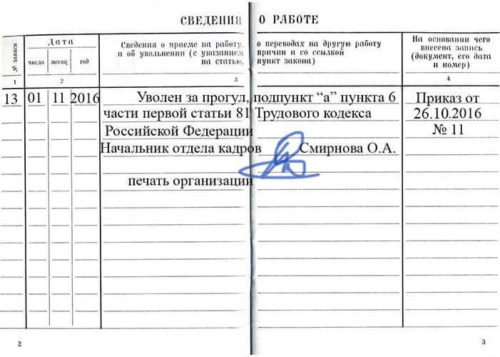Home / Labor Law / Responsibility / Disciplinary
Back
Published: 06/02/2016
Reading time: 9 min
0
7839
Absenteeism is a gross violation of labor discipline, for which the employer has the right to take disciplinary action against the employee .
Moreover, depending on the decision of management, this can be either a reprimand or a reprimand, or a more severe measure - dismissal. It is worth considering in more detail the features and conditions of application of each type of punishment, as well as situations in which it is better to choose one or another measure.
- General conditions for applying punishment The employee actually committed absenteeism
- An employer can prove that an employee committed a violation
Absence due to illness, but no supporting documents
It is not always possible to accurately determine the day an employee fell ill, because... he can seek medical help only the next day after the onset of the illness.
In this regard, the opinion of the Supreme Court of the Russian Federation is that the document justifying the absence of an employee from work - a sick leave certificate - confirms the employee’s incapacity for work, but not the moment of its onset, i.e. hour and minute. And even if the employee is unwell, and he left work before the end of the working day (shift, duty), but he received the certificate of incapacity for work only the next day, then in this case, dismissal for absenteeism will be illegal.
But it is necessary to take into account that before receiving sick leave, the employee must receive another document confirming his illness, for example, a certificate of seeking medical help or a certificate of health. Because not only a certificate of incapacity for work, but also a certificate or a doctor’s report can be evidence of an employee’s poor health.
But if an employee was absent from the workplace for a long time and provided a certificate of dental medical care as evidence of a valid reason, then such a reason will not be valid, because in this case, it confirms only a short visit to the doctor.
Good reasons
Employees must understand how many hours are considered absenteeism. Such a violation is recorded if a person is absent from the workplace for more than 4 hours. Before issuing an order on the basis of which a specialist is held accountable, the employer must ensure that there are no valid grounds. Good reasons include:
- illness of an employee, minor children or other disabled close relative represented by a family member;
- the occurrence of accidents at home, which leads to the need for their prompt elimination;
- the specialist is involved in legal proceedings as a jury;
- the citizen acts as a witness during operational or investigative activities;
- death or funeral of close relatives;
- getting into a car accident;
- the occurrence of force majeure, which includes accidents, fires, floods or other troubles, and they can be confirmed by certificates from the traffic police, the Criminal Code or other government agencies;
- the need to eliminate the destruction caused by natural disasters.
Only for absence without a valid reason can the employer take disciplinary action, which includes dismissal. The employee must have official documents that confirm certain reasons.
Absence due to a traffic accident
An employee is involved in an accident, and as a participant in it, he needs to wait for the arrival of traffic police officers. In this case, the reason for absence is valid, and the supporting document will be a certificate of the accident, which will indicate the date and time of the incident. Dismissal in such a situation for absenteeism will be illegal.
But if in such a situation the employee is absent from work the next day, for example, on the occasion of repairing a car or transporting it from another city, without informing the employer or manager about this, then this absence can be interpreted as absenteeism.
It must be taken into account that in all situations, the employee must negotiate his absence with the employer , obtain consent from him, and best of all, if it is in the form of an order or resolution on the submitted application.
How to prove good reasons?
Company managers do not have the right to fire specialists who were absent from work for good reason. These reasons are proven by official documents presented by:
- sick leave certificates filled out by employees of medical organizations;
- certificates from hospitals;
- subpoenas;
- certificates from traffic police officers;
- extracts from the Criminal Code.
Attention! The employee is obliged to notify the employer of the occurrence of certain problems, and also to inform that he will not be able to perform his job duties that day.
All other reasons are not considered valid, therefore, even if they exist, according to the Labor Code, the director can use a reprimand, reprimand or dismissal. Is absence from work for two hours considered absenteeism? Such behavior is recognized as lateness, and it will not be possible to fire an employee for such misconduct, although in case of repeated and correctly documented tardiness, the employer can terminate the employment contract under the article.
Went on vacation at my own expense without approval from my superiors
There are cases when an employer is obliged to provide an employee with leave without pay, for example, up to five days upon the death of a close relative, registration of a marriage, or the birth of a child. You need to negotiate with the employer if we are not talking about such exceptions.
Without agreement with the management of the organization, the employee does not have the right to go on vacation. In addition, upon a written application from the employee, the leave must be formalized by a personnel order indicating its duration and type, with familiarization against signature.
However, exceptions are possible to any rule. If it is impossible to comply with the procedure for taking leave at his own expense, the employee may resort to any means available to him to notify the employer of his possible absence from the workplace. If this condition is met, the courts usually side with the employee and recognize dismissal as an excessive punishment that does not correspond to the severity of the offense. But the assessment of the situation in court will depend on the circumstances and the integrity of the employee’s actions.
Ways to record absenteeism
An employer cannot unfoundedly declare that an employee is a truant. He is obliged to document the fact of failure to appear.
An incident is recorded in several steps, but the first and most important of them is confirmation of the fact of absenteeism. It can be confirmed by a report from the immediate superior, which sets out the circumstances. Printouts from the checkpoint indicating the absence of a mark indicating the passage of the turnstile, video recordings and other documents may also be attached. Absenteeism can be recorded only after four hours have passed and the employee has not arrived or reported himself in any way.
After the absence itself is confirmed, the management of the organization is obliged to create a commission that will confirm the absence in writing. An act is drawn up at the truant’s workplace. The act indicates the date and hours of the established absence. The form is signed by members of the commission, who can confirm that the person was not at the place of work at the specified hours.
Went on annual leave without permission
If an employee goes on annual leave without the required registration and without approval from his superiors, then you can be prepared for the fact that this can be defined as absenteeism. The decision of the courts proving the legality in this case is based on the fact that there is no evidence of the provision of the next vacation, its period has not been agreed upon, and the employee does not belong to the category for whom vacation can be used at a convenient time.
In this case, you should pay attention to the fact that if an employee goes on leave at his main place of work, this does not mean that he can go on part-time leave without approval and registration in the appropriate manner. This is confirmed by the judicial practice of the St. Petersburg City Court, where it was recognized that it was completely legal in a similar situation for the employer to fire a part-time worker for absenteeism.
What is considered absenteeism under the Labor Code
One of the types of disciplinary violation is truancy.
The Labor Code states that absenteeism is absence from work during the entire shift, regardless of its duration, or absence for four hours. Important! The following factors are of great importance:
- fact of absence. The employee performs his duties in accordance with job descriptions. They determine the specific place of work at which the fact of absence must be recorded. The Labor Code, in the content of Article 209, states that the entire territory of the employing organization is considered a workplace;
- the period of absence and the start of its countdown. Absence from work is punishable by dismissal for absenteeism. Labor legislation stipulates absence from work for four hours or more. However, the lunch break is not included in this period. If an employee was absent continuously for 4.5 hours, which included the established lunch time, then you cannot be fired for absenteeism. For such a violation, the employer issues a reprimand. To record the time of arrival, institutions introduce access control, fingerprint marks or written recording of arrival and departure.
A note in the work book about absenteeism is the final action in the dismissal procedure.
Put:
- record number;
- the date of the fact of dismissal, which coincides with the day of the order;
- indicating Article 81 of the Labor Code as a basis for dismissal;
- signature of the HR employee and company seal.
Note! The book must be issued on the last working day. If the dismissed employee fails to appear, he is sent a notification about receipt of the work book. If they don’t come for the book, it is kept by the employer.
You can also send written permission to send the work book to your place of registration, which will allow the manager to avoid sanctions for withholding the document.
Upon dismissal due to absenteeism, an employee may qualify for payment of the following financial resources in the general manner:
- calculation for fully worked days;
- financial compensation for unused vacation days;
- compensation for time spent on sick leave (if the employee was sick and had sick leave before the fact of dismissal).
When dismissed for absenteeism, an employee has the right to claim compensation for travel and other expenses that he incurred before the publication of the dismissal order. To avoid delays, the employee should take care to provide documentation that will confirm the expenses.
Attention! Our qualified lawyers will assist you free of charge and around the clock on any issues. Find out more here.
Types of truancy:
- Short-term – the location of the employee is known, it is possible to contact him.
- Long-term - location is unknown and communication with him is impossible.
In the first case, everything is much simpler: a memorandum and a certificate of the employee’s absence from the workplace are drawn up in the name of the manager. An explanatory note is requested from the employee, which must be submitted within 2 working days (Article 193 of the Labor Code of the Russian Federation). Failure to provide an explanatory note does not prevent the imposition of a penalty; an act of refusal to provide written explanations is simply drawn up, which must be signed by the employee himself and 3 witnesses. Next, an order is drawn up to impose a disciplinary sanction, and the day the employee is not at work is recorded in the report card as absenteeism.
In the second case, the difficulty is that it is necessary to wait for the person to go to work in order to request an explanation from him, since all formalities must be observed.
The reasons may be valid, then, if the case goes to court, the employee will be reinstated at work. Therefore, absenteeism should be recorded in strict accordance with labor legislation, observing all formalities.
Absenteeism is punished very strictly, including dismissal. This differs from the banal being late for work. The fact of absenteeism must be documented - an entry must be made in the working time log, recorded by CCTV cameras. According to labor law, dismissal for absenteeism is possible within a month from the day the misconduct was discovered, not counting the employee’s time on sick leave or vacation.
An entry in the labor record upon dismissal for absenteeism completes the dismissal procedure. Entered:
- Record serial number;
- The date of dismissal coinciding with the day of the order;
- Record of dismissal for absenteeism and a link to Article 81 of the Labor Code of the Russian Federation;
- Signature of the personnel officer and seal of the organization.
The book is issued on the last day of work. If the dismissed person fails to appear, a notification is sent to receive a work permit. If they don’t show up for the book, it continues to be stored at the last place of work. It is also possible to send written permission to forward the work report to the place of registration, which will relieve the boss of a fine for withholding the document.
Payments include all salary debts, sick leave, and unspent vacation.
By the way, it’s useful to know how to restore a work book if it’s lost?
Absence due to bad weather conditions
In the event that the reason for an employee’s absence from work was bad weather conditions, and they are not related to emergency situations, then this can be regarded as absenteeism. This is because under these circumstances it is possible to get to work or inform the employer.
However, the Supreme Court of the Russian Federation, in a case dated September 12, 2019, ruled that an employee’s absence from work due to bad weather conditions may be a valid reason.
What is considered absenteeism according to the Labor Code of the Russian Federation?

The law says: dismissal under an article for gross violation of Labor Code norms is formalized at the initiative of the employer, on the basis of a corresponding written order (in the T-8 form). One of the disciplinary offenses is absenteeism. The Labor Code of the Russian Federation defines absenteeism as absence from the workplace without good reason throughout the entire shift, regardless of its duration, or for 4 hours in a row without good reason. That is, the duration is from 4 hours to one day. This is recorded in the timesheet. The report card will become indisputable evidence.
- The fact that the employee is absent from the workplace.
The worker performs his duties in accordance with the job description. It determines the specific place where the fact of absence during the working day is recorded. The Labor Code of the Russian Federation refers to Article 209, where the workplace is the entire territory of the employing company.
- The time of absence of the employee and the beginning of its countdown (in the time sheet).
Absence from work is a gross violation of the employment contract and entails sanctions in the form of termination of the relationship and dismissal for absenteeism. An article of labor legislation indicates absence from the workplace for more than 4 hours in a row during the working day. In this case, the lunch break does not count.
If the employee was not at the workplace without valid reasons and circumstances for a continuous 4.5 hours, which included a regulated lunch, then it is impossible to dismiss the employee under the article for absenteeism on the initiative of the employer. Violated? For this reason, the manager issues warnings, and if these warnings are ignored, a reprimand is issued. To record the moment of arrival, enterprises introduce passes, fingerprint marks or written recording of the actions of arrival and departure.
The reason for the dismissal was the employee's wedding
In the organization where the employee worked, the collective agreement provided for the provision of leave to employees on the occasion of marriage registration for a period of up to five calendar days, one of which was provided with payment in the amount of the tariff rate (salary), and the rest - without pay.
The employee notified his immediate supervisor in advance of his absence from work in connection with the marriage registration orally. However, upon returning to work, the employee was required to explain the reasons for his absence in writing, after which he was fired for absenteeism.
Since the employee believed that he was fired illegally, he went to the court of the city of Khabarovsk (case No. 2-1303 / 2015 dated 04/01/15). His demands were: compensation for wages for forced absence, reinstatement to his job and compensation for moral damage.
The court of first instance, refusing to satisfy the claim and siding with the employer, argued that the reason for the employee’s absence from the workplace was not valid, because he did not notify in writing of his need to take time off in connection with the marriage registration.
The appeal decision of the Judicial Collegium for Civil Cases of the Khabarovsk Regional Court was diametrically opposite (case No. 33-3783 / 2015 dated June 24, 2015). According to the collective agreement, the plaintiff cannot be denied leave for marriage.
The fact that there is no written application for time off for personal reasons is not a reason for disciplinary action . This violation does not exclude the possibility that the employee may have a valid reason for absence. Since no adverse consequences arose as a result of this, the employee had not previously been brought to disciplinary liability, the court concluded that when dismissing the employee, the reason for his absence from work and the severity of the offense were not taken into account.
Ultimately, the court declared the dismissal illegal, the employee was reinstated, and the employer was ordered to pay the employee the average wage for the period of forced absence, as well as compensate for the moral damage caused.
Reprimand as a punishment for absenteeism
In essence, a reprimand is not much different from a reprimand, but this measure is still more serious.
For example, some enterprises introduce a system of punishment for employees in which the presence of several reprimands is grounds for subsequent dismissal. A reprimand is a negative assessment of an employee’s actions by the employer, expressed by the latter in official form. Like a reprimand, a reprimand is not noted in the work record book, but can be displayed on the employee’s personal card.
The procedure for issuing a reprimand is similar to applying a reprimand and includes the following actions:
- Preparation of documents confirming the employee’s guilt (absenteeism report and memo).
- Receiving a written explanation from the employee (in case of refusal to provide an explanation, a report is also drawn up).
- The employer's decision regarding the employee's guilt. For example, if the reason for absenteeism was valid (a summons to court, an accident, illness) and the employee is able to confirm this, punishment may not be applied.
- Issuing an order to reprimand the employee. Within three working days he must be familiarized with it against his signature.
This is also important to know:
Who imposes a disciplinary sanction for violating sanitary legislation and what is the procedure for registration
The terms for imposing a reprimand are the same as for a reprimand - six months and a month from the date of commission and discovery of the offense, respectively.
After the end of the year, the reprimand is also removed from the employee, unless during this time he has committed new disciplinary offenses.
Actions on the part of the employer
The supervisor must contact the employee to determine the reasons for absence. If this cannot be done, a registered letter is sent to a known residential address, which sets out the requirement to provide explanations regarding the reasons for absence from work.
The citizen is given a two-day period to respond to the employer’s administration, during which he is obliged to submit an explanatory note.
If the letter is returned with a note that the citizen is absent from the specified address, the employer must contact neighbors or the police station in order to find out the whereabouts of the employee.
This measure is necessary, because if an employee is detected and compelling reasons are provided for the person’s absence from the workplace, the employee is subject to full reinstatement through the court.
Thus, a mandatory condition for dismissal under the article for absenteeism will be the presentation of conclusive evidence of the very fact of absenteeism without a good reason. The following documents will help document the fact that an employee is absent from the workplace:
- Entry in the report card.
- A document drawn up establishing the fact of the employee’s absence.
- A notice sent to the employee's home address asking him to return to work.
By following this step-by-step procedure, the administration will be able to fire a truant without any undesirable consequences in the future:
- Obtaining grounds for dismissal - drawing up an absence certificate. The act is drawn up in free form, but must necessarily reflect information about the specific day, time, and duration of absence.
- Certification of the act by witnesses.
- If there are several absences, a report is signed for each day of absence.
- Explanatory Requirement. If an employee appears at the workplace, the administration requires an explanation for the unapproved absence
- Within two days after receiving the request to provide an explanatory note, the employee prepares a note outlining the reasons for his absence.
- If the note is not provided within the required period, this is recorded in the presence of three witnesses in the relevant act.
- The manager prepares a memo addressed to the director of the organization with a note from the employee attached.
- If the reason for non-appearance is considered disrespectful, an order is issued in the strictly established T-8 form.
This order serves as the basis for further dismissal procedures. Since any deviation from the standard established by law will allow it to be challenged in court . When drawing up and issuing an order, follow the following instructions:
- The date of termination of the employment agreement must be reflected.
- The reason for dismissal is indicated.
- The order mentions the documents that served as confirmation of absenteeism.
Three days are allotted for the employee to familiarize himself with the order, followed by registration of the order in a special personnel register. Changes are made to the work time sheet: the NN mark changes to PR, which records the fact of absenteeism.
It is very important to fire a negligent employee correctly by making correct entries in the employment record:
- in the first column indicate the entry number in order;
- in the second - the date of the event;
- the third column is filled in with information about dismissal indicating Article 81 of the Labor Code of the Russian Federation;
- in the fourth indicate the number and date of the order.

After completion of the registration, the employee is given the latest documents, payroll documents, and if the employee does not show up for work, if it is impossible to hand over the documents, they are sent to the address of the dismissed person by registered mail.
This is also important to know:
Is information about disciplinary sanctions entered into the work book: how is the entry made?
Before giving the work record to the dismissed person, the records are duplicated into a personal card in the T-2 form and certified by the employee’s signature. Each entry from the labor record must be reflected in the card and certified by the signature of the dismissed employee .
According to Article 81 of the Labor Code (clause a, clause 6.p.1), as a basis for dismissal, an entry is made in the labor report about dismissal “in connection with a single gross violation of labor duties.” To avoid problems with the Social Insurance Fund in the future, a copy is made of the work book and transferred to the archive.
Reasons for absence from work
The Labor Code does not provide a list of valid reasons for absence from work; usually these are considered to be events supported by documentary evidence. In the event of an appeal against dismissal, the court will not consider the following to be absenteeism:
- temporary loss of ability to work due to health reasons - a certificate from the treating organization is required;
- emergency situations (natural disasters, communal troubles, misfortune that happened to loved ones);
- transport problems (disruption of public transport, flight delays or cancellations, etc.) - it is better to obtain a certificate from the transport company;
- performance during working hours of public or state duties provided for in Art. 170 Labor Code of the Russian Federation;
- donation;
- strike of company employees;
- the employee being in custody;
- absenteeism from work overtime;
- disagreement to interrupt a planned vacation;
- absence from performing activities prohibited to the employee for medical reasons;
- refusal to transfer to work in another location.
IMPORTANT INFORMATION! If an enterprise delays employees’ salaries for more than 15 days, then employees can suspend work activities by notifying their superiors in writing, and this cannot be regarded as absenteeism.
If the manager voluntarily released the employee at his request, of course, his absence is not absenteeism. But if the boss wants to fire a person for some reason, he may take advantage of this situation in bad faith if permission to leave the job was given privately. If the employee is not on the best terms with the employer, then in such circumstances it is better to record the permission in writing or talk to the manager in the presence of several people.
Circumstances vary. A worker may not appear due to both significant and insignificant reasons for absence during the working day and must make an explanation.
Valid grounds for absence from work for more than 4 hours in a row (they are documented):
- Illness of an employee or a close relative, such as a child;
- Death of relatives;
- Utility accidents and accidents;
- Force Majeure.
Unexcused reasons for absence from work are other events that are not valid for obtaining leniency from superiors. A specific case of absenteeism without valid reasons and circumstances remains at the discretion of the manager, based on the value and personal characteristics of the employee. A number of reasons for absence during a shift can be forgiven for a good employee. After all, one order can ruin a person’s life.
Employer's procedure
- An absence from work report is drawn up. The act is drawn up in any form and must be certified by at least 3 witnesses. Each day of absenteeism is documented in a separate document.
- Requesting an explanation from an employee for the fact of absenteeism - on the day he returns to work, give a notice requesting a written explanation for the fact of absence from work. According to the Labor Code, the employee is given 2 working days to give explanations indicating good reasons for the offense committed. In case of failure to provide an explanatory note, an act is drawn up, which is signed by the compiler himself and at least 3 witnesses.
- A memo is drawn up about the fact of absence from the workplace - written in any form. An explanation for the fact of absence from one's place is attached to the note.
- An order of dismissal for absenteeism is issued - it has a unified form and must be executed properly.
- The order is recorded in the personnel order log.
- A payslip is drawn up with the employee, which has a unified form. Full payment is made on the last day of dismissal.
- The HR department informs the employee of the dismissal order within 3 working days against signature. To be on the safe side, it is important to draw up, along with the order, an act of refusal to sign in order to familiarize yourself with this order. The act is signed in the presence of the employee by the compiler himself and 3 witnesses.
- A record of termination of the employment contract is made in the personal card. This document is signed by the HR officer and the employee. If he refuses to sign, a corresponding entry is made on the card.
- Making an entry about the termination of the employment contract in the employee’s work book.
- Issuance of a work book - the employer is obliged to issue a work book on the day of dismissal with an entry about the dismissal. The issuance is confirmed by an entry in the work book movement book. If delivery is not possible, then the employer sends it to the postal address with notification of delivery to the addressee.
- The employee is paid in full for work on the last day of dismissal, and days of unused vacation are also paid.
The dismissal procedure can be divided into three stages:
- documenting the fact of the employee’s absence from work;
- finding out the reasons for non-appearance;
- making a decision and issuing an order of dismissal.
You can make a procedural error at any of these stages, but every minor violation can cost the company dearly! Do not forget that an employee who is outraged by what he considers to be an unjustified dismissal has the right to go to court. If he also uses the services of a good lawyer, the matter will probably turn out not in your favor.
We invite you to familiarize yourself with: Employee rights upon dismissal of his own free will, layoff, or employer’s initiative
Preparation of the act
A correctly drawn up act is the main evidence of an employee’s violation of labor laws. The act has the following structure:
- name (act of absence from work, absenteeism, absence from work - different name options are acceptable);
- date, place and time of compilation;
- Full name of the official drawing up the act (such a person can be either the head of the company or the head of a structural unit);
- Full name of the employee who did not show up for work;
- the circumstances of the employee’s absence (this part should be filled out in as much detail as possible, indicating the exact time of absence and the actions taken by the employer - attempts to reach the truant or contact him in some other way);
- date and duration of the employee’s absence (indicating the exact time, “minute to minute”);
- the date of drawing up the act and the signature of the manager (for greater confidence, you can ask witnesses to sign - for example, colleagues of the truant).
It is advisable to draw up the act on the same day, without putting it off “until tomorrow.”
Before signing an order to dismiss an employee for absenteeism under the article, you need to require an explanatory note from him. At this stage, it is important to document every action, so it is better to send the request for an explanatory note to the employee in writing (even if in the end he did come to work).

After requesting an explanation for failure to appear, you must wait two days. By the way, this rule applies even if the employee refuses to “give evidence” immediately - what if he changes his mind? If after two days the answer still does not come, you can move on to the final stage and draw up an order.
Let's assume that the employee nevertheless provided an explanatory note. There are three possible options:
- The reason for absence indicated by the employee can be classified as valid, and the stated arguments are supported by documents. In this case, the person cannot be fired.
- The truant is clearly making things up: the explanations are unconvincing and there is no evidence. Feel free to write an order.
- The situation is ambiguous. There are no supporting documents or they are insufficient, but the arguments look convincing. Or vice versa - there is a certificate from the medical center. institutions, but probably “fake”. What should an employer do? It is impossible to give a definite answer to this question. Try to assess the situation as a whole, taking into account all possible motives of the employee, his previous behavior, attitude towards his duties and the work process in general. Don’t forget – the law gives you the right to draw a conclusion and make a decision.
An order to dismiss an employee for absenteeism without good reason is drawn up and issued according to the unified form No. T-8. The law establishes the following deadlines for issuing an order:
- no earlier than two days from the moment the request for an explanatory note is sent to the truant;
- no later than 30 days from the date of absence.
Structure of the order according to form No. T-8:
- Name;
- date, place of compilation;
- grounds for publication (absenteeism act, details of reports and explanatory notes, etc.);
- Full name and position of the employee;
- a detailed description of the offense;
- justification of why the reasons for absenteeism cannot be recognized as valid;
- clarification of the employee’s right to appeal the dismissal decision;
- date of compilation and signature of the employer.
The employee must read the order and confirm with his signature that he is aware of its contents. If he refuses to do this, another act will have to be drawn up. After this, you should make an entry about the dismissal in the work book of the negligent specialist and send him to the accounting department for this book. This completes the dismissal procedure.
The procedure for dismissing an employee for absenteeism
When dismissing certain categories of workers for absenteeism, in practice, nuances or prohibitions on certain actions appear.
According to labor legislation, an employer is not allowed to fire for absenteeism:
- pregnant women;
- single mothers raising a child (children) under fourteen years of age;
- fathers or mothers with many children with children under three years of age;
- parent or sole breadwinner of a child with a disability who is under 18 years of age.
Employees who work part-time or young workers can be fired for absenteeism on a general basis. If a part-time employee documents the employer three working days in advance about the refusal to perform additional work, this cannot be considered absenteeism.
Preparation of the act
Another option is dismissal by agreement of the parties. Here the initiative to end the relationship lies with both the employee and the employer. But even here, in order to be on the safe side, it is necessary to draw up a separate act, in which you need to write down an agreement on termination of the employment contract, which indicates the date of termination and its basis.
This dismissal is distinguished by its versatility. After all, in this case, the employee can be fired, even if he is on a certificate of incapacity for work. The nuance here is that it is impossible to cancel such an agreement unilaterally.
Dismissal of a pregnant woman at the initiative of the employer, that is, under Art. 261 of the Labor Code of the Russian Federation, impossible. In this case, it will be legal to reinstate her at work after presenting a certificate of pregnancy.
Dismissal of an employee during a probationary period is possible as a result of dissatisfaction with the results of the trial. In this case, the employer is required to notify him of the results of the test at least 3 working days in advance and dismiss him as having failed the test before the end of the probationary period.
By virtue of Art. 81 of the Labor Code of the Russian Federation, the employer, on his own initiative, issues an order to terminate the employment contract with an employee on a probationary period, indicating the reasons for its termination. The reasons can be attached as a separate document to the order (you need to specify which tasks it failed to complete). Records that an employee worked poorly are considered illegal. An employee can resign of his own free will during the probationary period by notifying the employer 3 days in advance and writing a statement.








